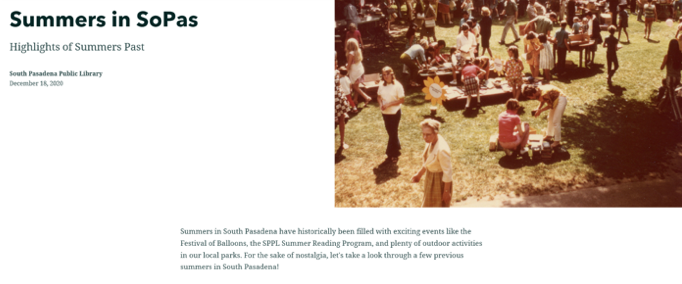Guest post by: Olivia Radbill, Adult Services/Local History Librarian, South Pasadena Public Library
This post is part of a series written by members of Internet Archive’s Community Webs program. Community Webs advances the capacity for community-focused memory organizations to build web and digital archives documenting local histories and underrepresented voices. For more information, visit communitywebs.archive-it.org/
The South Pasadena Public Library (SPPL) is a single branch library system located in the small city of South Pasadena, California, just fifteen minutes from downtown Los Angeles. SPPL serves a population of approximately 25,000 residents, many of whom are very dedicated to preservation and local history. As the Adult Services/Local History Librarian at SPPL, I regularly interact with local organizations, City staff, City commissioners, and residents in search of the many little-known details of South Pasadena’s history. My role not only entails organizing, processing, and making accessible local history, but also archiving current events that will inevitably be the subject of future research.
At the onset of the COVID-19 pandemic, when the SPPL building was first shut down and our physical Local History Collection made inaccessible, Library staff sought to provide means of bringing local history to digital platforms in a consistent and manageable way. Our first means of public outreach was through the creation of digital exhibits using ArcGIS Storymaps, an interactive web-mapping tool used to host narrative multimedia displays. Exhibits in the series include Ray Bradbury: Celebrating 100 Years, South Pasadena Public Library: Twelve Decades and Counting, City of Trees: Our Urban Tree Canopy, Summers in SoPas: Highlights of Summers Past, and COVID-19: Living History Project. To date, this series has garnered thousands of views.

While this series did quell some of the community desire to interact with the Local History Collection, it did not address the needs of the community in regards to born-digital content. The COVID-19 pandemic highlighted certain gaps in our collection. One of the most notable gaps was the lack of any born-digital or web-archived content. Previously, SPPL has relied primarily on physical donations and physical City documentation. However, once these objects became inaccessible to both Library staff and patrons during our initial COVID-19 closure in March 2020, we sought means of preserving documentation that has increasingly moved to exclusively web-based platforms. For example, in April 2020 the City of South Pasadena launched “City Hall Scoop”, an online blog intended to provide quick, reliable news updates to local residents. It became imperative for Library staff to actively seek out and ensure preservation of this kind of content.

At the onset of our involvement in the Community Webs program, I strove to ensure that the objective of our internet archiving was specific, consistent, and attainable. After careful consideration, the following categories were determined to be priorities to the SPPL Local History Collection: City Government, Local Newspapers, and Nonprofit Organizations. Based on these categories we have identified many relevant websites, but chose to focus primarily on official websites and social media pages, to add to the Archive-It platform. The Community Webs project has been an invaluable resource for addressing the needs of both the SPPL staff and the community. Online trainings have aided significantly in overcoming learning curves, helped us determine the scope of our archiving project, and have allowed SPPL to create a system in which web-based content is an integral part of our Local History Collection. SPPL, as of March 2022, has archived, either singularly or on a recurring basis, eleven websites. We are hoping to archive 22 new sites by the end of the year, doubling the number we reached last year.